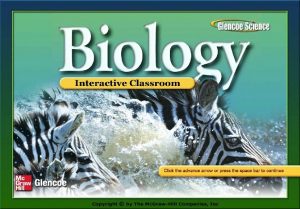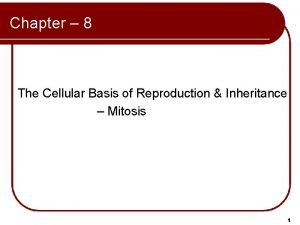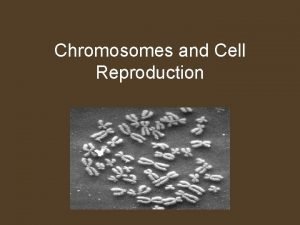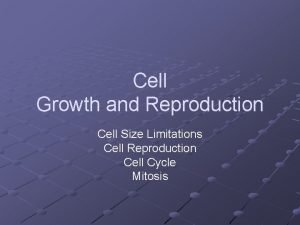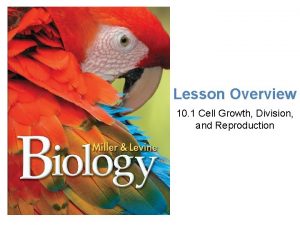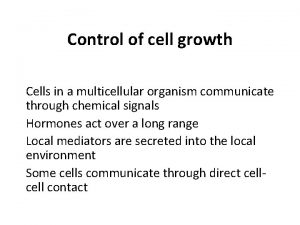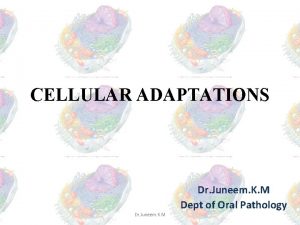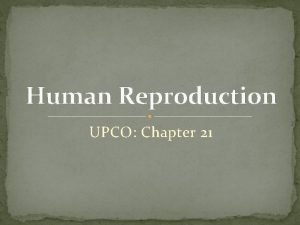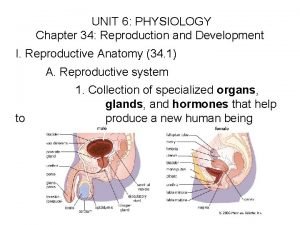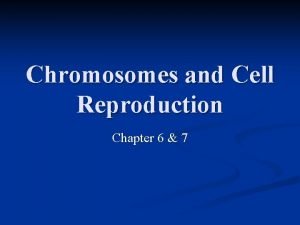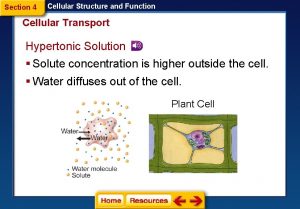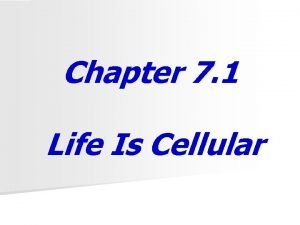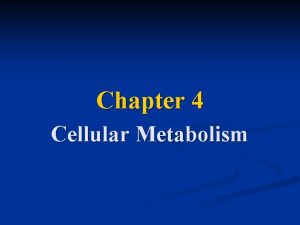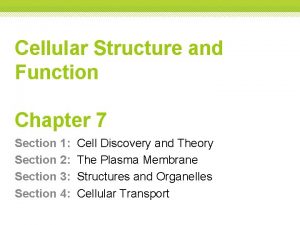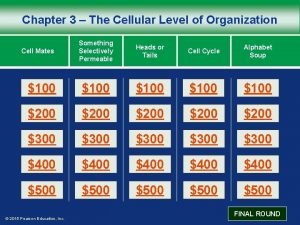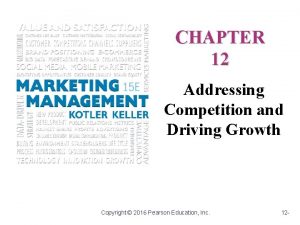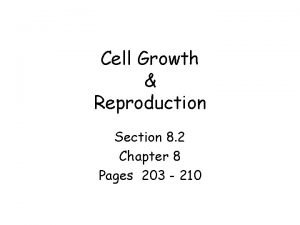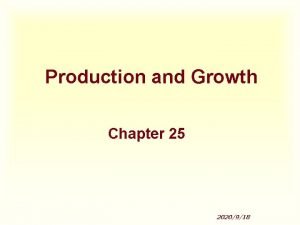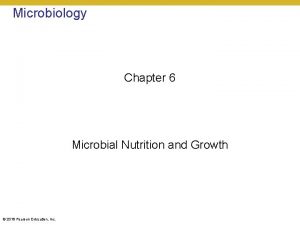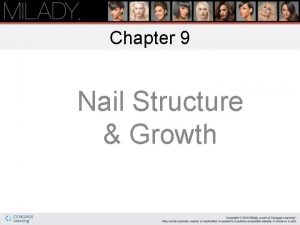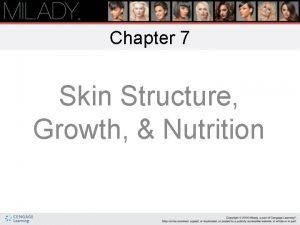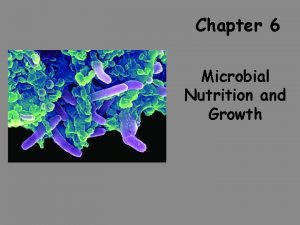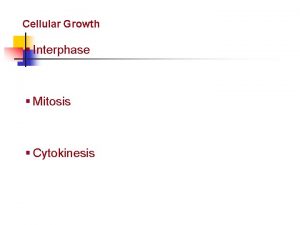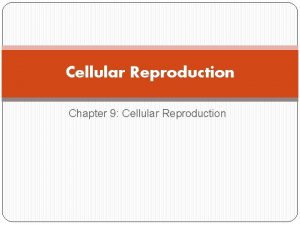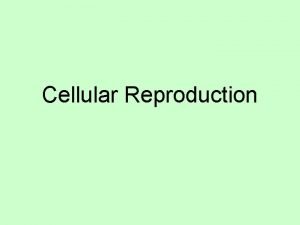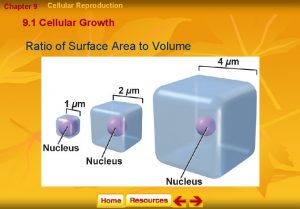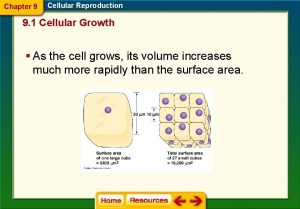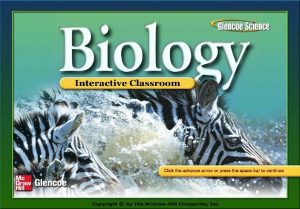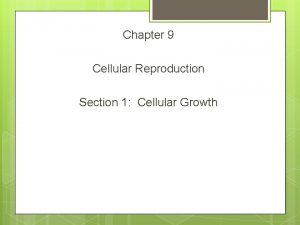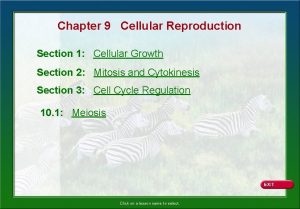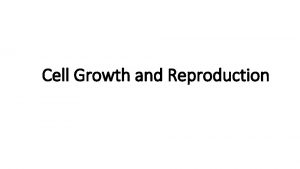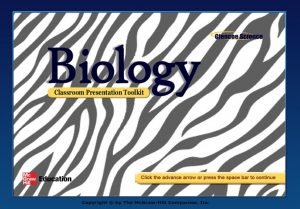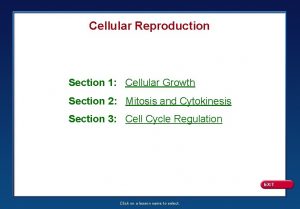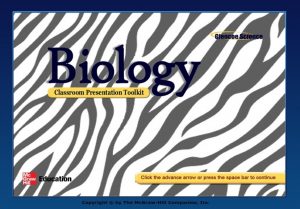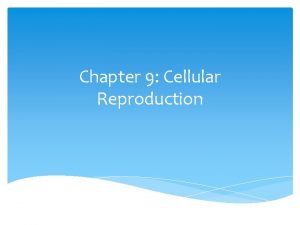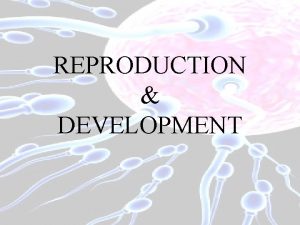Chapter 9 Cellular Reproduction 9 1 Cellular Growth

















































- Slides: 49

Chapter 9 Cellular Reproduction 9. 1 Cellular Growth 1

Cells Come in Different Sizes n n n Red Blood Cell 8 um in diameter Nerve Cell 1 m in length with very small diameter Yolk of ostrich egg 8 cm Most cells are 2 -200 um 1000 um = 1 mm 2

Limits to Cell Size 1. 2. 3. Diffusion DNA Surface to volume ratio 3

Diffusion Limits Cell Size n n Within the cell nutrients must diffuse to all parts Diffusion is based on random movement of particles Diffusion is too slow for a large cell When cells reach maximum size they die or divide 4

DNA Limits Cell Size n n DNA contains all the instructions for synthesizing proteins (including enzymes) Large cells would need more proteins More copies of the DNA instructions would be needed for a large cell Most cells contain only one set of DNA 5

Surface Area to Volume Ratio Limits Cell Size n n n As the size of a cell increases the volume increases faster than the surface area If the cell size is doubled then need eight times more nutrients but plasma membrane is only four times larger Cells divide before they become too large to function properly 6

Volume Increases Faster than Surface Area What are the surface area to volume ratios? 7

The Cell Cycle n n Sequence of growth and division of a cell Two main periods Growth also called interphase n Division also called mitosis and cytokinesis n 8

Cell Cycle 9

Interphase n n NOT part of mitosis, rather the time between one mitosis and the next Stages of interphase G 1 phase: rapid growth and metabolic activity n S phase: synthesis of DNA (additional copy is made) n G 2 phase: centrioles and other organelles replicate; cell prepares for division n 10

Chromosomes and Chromatin n n Both are DNA Chromosomes are the condensed form of DNA that is visible as individual strands. Chromatin is the “relaxed” very thin form of DNA that is not visible as individual strands. During interphase DNA is in the chromatin form. 11

Chromosomes and Chromatin DNA form Chromosome DNA form Chromatin DNA form 12

13

Cell Reproduction n n Process of producing new cells from preexisting cells Three Types n n n Fission: bacteria Meiosis: sex cells Mitosis: body cells n n Needed for growth Needed for repair 14

Bacteria Reproduce by Fission n n Prokaryotes do not have a nucleus They divide the cell contents then divide 15

Chapter 9 Cellular Reproduction 9. 2 Mitosis and Cytokinesis 16

Eukaryote Cell Reproduction is Mitosis and Cytokinesis n Mitosis is division of the nucleus producing two genetically identical daughter cells from one parent cells n n Needed for growth Needed for repair Cytokinesis is division of the cell contents Usually they happen simultaneously 17

Phases of Mitosis n n Prophase Metaphase Anaphase Telophase 18

Chromosome Structure n n n Chromosome is two sister chromatids connected by a centromere Chromosomes are made of DNA and contain genes (hereditary units) Chromosomes are the condensed form of chromatin 19

Prophase n n n Chromatin coils into visible chromosomes Nuclear membrane disintegrates Nucleus disappears Centrioles migrate to opposite ends of cell Spindle fibers form 20

Prophase 21

Metaphase n n n Much shorter amount of time than prophase Spindle fibers attach to centromere Chromatids line up at the cell’s equator 22

Metaphase 23

Anaphase n n n Centromeres split Spindle fibers shorten to pull chromatids to each end of cell Sister chromatids separate 24

Anaphase 25

Telophase n n n Starts when chromatids get to opposite poles Chromosome uncoil and become chromatin Spindles breakdown Nuclear membrane reforms Nucleus becomes visible 26

Telophase 27

Cytokinesis n n n Division of the cytoplasm Plants form a cell plate, the beginning of a cell wall Animals have cleavage furrow where the plasma membrane pinches in 28

Animal and Plant Cytokinesis 29

Results of Mitosis n Mitosis allows for genetic continuity in each generation of daughter cells n n n Same chromosomes Same genes Same exact DNA 30

Levels of Organization n n In unicellular organisms one organism undergoes mitosis to make two organisms In multicellular organisms one cell undergoes mitosis to make two cells that form tissues n n n Tissues of different types functioning together form organs Organs functioning together form systems Systems functioning together form organisms 31

Chapter 9 Cellular Reproduction 9. 3 Cell Cycle Regulation 32

33

Length of Cell Cycle n Each cell type has a specific growth and reproduction time table Frog embryo cell cycle of less than one hour n Cells lining your intestine 24 -48 hours n Mature nerve cells do not divide n 34

Normal Control of the Cell Cycle n n Much that science does not fully understand Enzymes control the cell cycle Many enzymes needed n Most enzymes are used at just one point in the cycle n Loss of a functional enzyme can cause the cell cycle to be “out of control” n 35

Normal Control of the Cell Cycle n n Signaling molecules made of a cyclin bound to a CDK kick off the cell cycle and drive it through mitosis. Checkpoints monitor the cell cycle for errors and can stop the cycle if an error occurs CDK are enzymes, cyclins are proteins 36

Genes and Proteins n n Genes located on DNA are responsible for giving direction about what proteins (enzymes) to produce A defective gene would produce a faculty enzyme that would not function correctly 37

Key Time for Control of the Cell Cycle n n Key control of the cell cycle is just prior to S phase during interphase If new DNA is synthesized then the cell will continue on with mitosis 38

Cancer n n A cell “out of control” of the cell cycle Mistake in the Cell Cycle Too fast rate of mitosis Result of changes in one or more genes that produce enzymes that are involved in controlling the cell cycle 39

Cancer Cells 40

Cancer Cells n n n Cancer cells form tumors Tumors are masses of cells that interfere with normal functioning Metastasis: cancer cells break off the tumor and travel to other locations to form tumors 41

Causes of Cancer n n n Both genetic and environmental When people move from one country to another their rate of cancer is that of the country they are now living Example: Rate of breast cancer is high in US and low in Japan; when people move from Japan to US their rate of breast cancer increases 42

Environmental Causes of Cancer Smoking UV Light Diet Air Pollution 43

Environmental Causes of Cancer Water Pollution Viruses Cervical Cancer 44

Cancer Prevention n n Clear link between healthy lifestyles and incidence of cancer Low fat, high fiber diet reduces risk Daily exercise reduces risk No tobacco in any form reduces risk 45

Apoptosis n n n Programmed cell death All animal cells have a “death program” Fetal human tail cells have undergone apoptosis; programmed cell death at the appropriate time Plant leaves undergo apoptosis in autumn when the leaves are falling Apoptosis can help protect organisms from developing cancerous growths. 46

Stem Cells n Stem cells are unspecialized cells that can develop into specialized cells under the right conditions 47

Embryonic Stem Cells n n n After a sperm fertilizes an egg the cell divides until there is 100 -150 cells Each of these cells can develop into a wide variety of specialized cells Much controversy exists due to the ethical concerns about the source of these embryonic stem cells 48

Adult Stem Cells n n Present in adults (and newborns) to produce the same type of cell Not pluripotent (can’t become any cell type) In 2000 adult stem cells ere used to restore lost brain tissue in mice Less controversy exists to the use of adult stem cells 49
 Chapter 9 cellular reproduction
Chapter 9 cellular reproduction Chapter 9 cellular reproduction answer key
Chapter 9 cellular reproduction answer key Chapter 9 cellular reproduction
Chapter 9 cellular reproduction Chapter 8 cellular reproduction cells from cells
Chapter 8 cellular reproduction cells from cells The disadvantages of sexual reproduction
The disadvantages of sexual reproduction Asexualk
Asexualk Asexual reproduction vs sexual reproduction venn diagram
Asexual reproduction vs sexual reproduction venn diagram The cellular basis of reproduction and inheritance
The cellular basis of reproduction and inheritance Growth and reproduction
Growth and reproduction Growth and reproduction
Growth and reproduction Cell growth division and reproduction
Cell growth division and reproduction Cellular adaptation of growth and differentiation
Cellular adaptation of growth and differentiation Cellular adaptation of growth and differentiation
Cellular adaptation of growth and differentiation Absolute growth rate and relative growth rate
Absolute growth rate and relative growth rate Monocots eudicots
Monocots eudicots Step growth polymerization vs chain growth
Step growth polymerization vs chain growth Primary growth and secondary growth in plants
Primary growth and secondary growth in plants Chapter 35 plant structure growth and development
Chapter 35 plant structure growth and development Geometric exponential growth
Geometric exponential growth Neoclassical growth theory vs. endogenous growth theory
Neoclassical growth theory vs. endogenous growth theory Difference between organic and inorganic growth
Difference between organic and inorganic growth Chapter 20 sexual reproduction in animals
Chapter 20 sexual reproduction in animals Chapter 10 sexual reproduction and genetics
Chapter 10 sexual reproduction and genetics Reproduction in human
Reproduction in human Lesson 20.2 the male reproductive system
Lesson 20.2 the male reproductive system Chapter 19 asexual reproduction
Chapter 19 asexual reproduction Chapter 10 sexual reproduction and genetics
Chapter 10 sexual reproduction and genetics Chapter 34 reproduction and development answer key
Chapter 34 reproduction and development answer key Chapter 6 chromosomes and cell reproduction
Chapter 6 chromosomes and cell reproduction Chapter 8 section 3 cellular respiration continued
Chapter 8 section 3 cellular respiration continued Chapter 8 lesson 1 life is cellular
Chapter 8 lesson 1 life is cellular Section 4 cellular transport answer key
Section 4 cellular transport answer key Chapter 7-1 life is cellular answer key
Chapter 7-1 life is cellular answer key Chapter 4 cellular metabolism
Chapter 4 cellular metabolism Chapter 7 section 4 cellular transport
Chapter 7 section 4 cellular transport Cellular respiration harvesting chemical energy
Cellular respiration harvesting chemical energy Explain how amp stimulates cellular respiration
Explain how amp stimulates cellular respiration Chapter 9: cellular respiration: harvesting chemical energy
Chapter 9: cellular respiration: harvesting chemical energy Chapter 3 the cellular level of organization
Chapter 3 the cellular level of organization Microbiology chapter 7 microbial growth
Microbiology chapter 7 microbial growth Milady nail structure and growth
Milady nail structure and growth Chapter 30 money growth and inflation
Chapter 30 money growth and inflation Responsive anticipation and creative anticipation
Responsive anticipation and creative anticipation Section 8-2 cell division
Section 8-2 cell division Lesson 2 moving west
Lesson 2 moving west Chapter 25 production and growth
Chapter 25 production and growth Chapter 6 microbial nutrition and growth
Chapter 6 microbial nutrition and growth Describe the appearance of a normal healthy nail
Describe the appearance of a normal healthy nail Skin structure growth and nutrition
Skin structure growth and nutrition Chapter 6 microbial nutrition and growth
Chapter 6 microbial nutrition and growth

